The kitchen garden this year has been running a little behind. Somewhere around February, peak seed starting time, we found ourselves knee deep in barn building, instead of sowing seeds in the greenhouse. Once the barn was finished, we had to scramble to catch up.
As such, a few things are getting planted a little late this year, but our growing season is quite long, and I expect it will all work out in the end.
This last weekend I could sum up in about four words. Pick. Shell. Blanch. Freeze. First it was the favas.
They were originally intended to be planted as a nitrogen-fixing cover crop, and simply turned into the soil. However, by the time the barn was well underway, the plants were already blooming, and it seemed a shame to stop them. At that point, it just made sense to let them go ahead and make beans.
The problem is, we planted a LOT of favas, and they made a LOT of beans!
The plants were host to a lot of aphids this spring too, but with aphids, come beneficial aphid-eating insects, including these soldier beetles.
We also found a lot of lady beetles lurking among the fava foliage too.
I think we’re both officially fava-beaned out though. Don’t get me wrong. I love fava beans, especially fresh from the garden, but when you’re drowning in favas, the pod-popping gets quite monotonous after a while. Then there’s the blanching, and for most of the larger beans, the tedious final step.
Skinning.
I usually think it’s difficult to improve upon nature, but when it comes to favas, I can’t help but feel they suffer from a slight case of over-packaging.
It’s a good thing they’re delicious.
Moving past the fast and furious fava festivities, next it was time to attack the pea bed. We’ve had some very warm weather recently, which will soon spell the end for pea season. We hurried things along though, and harvested the last of the peas to free up some space in the garden.
The snap peas were plentiful, and easy to pick, trim, and blanch for storing.
The shelling peas though meant more pod popping.
Thankfully though, it’s much easier to liberate peas from their pods than favas.
The only danger here is that they taste wonderfully sweet straight from the pod, so not all of them made their way to the kitchen.
In recent weeks the greenhouse has been so crowded that even getting in the door has been a challenge. Thankfully though, with the spring peas out of the way, we freed up some space in the garden.
Over the long weekend we finally struck another project off the list. We’ve been meaning to add the last of the raised garden beds to the vegetable garden, ever since we finished the greenhouse installation last year. We kept getting distracted with other projects though, so in an attempt to reclaim some of the space in the greenhouse, we finally knocked out the rest of the raised bed construction.
This of course meant hauling lots of soil to fill them, and installing the irrigation lines for each of the new beds, but it feels good to finally get it done, and be able to factor these new beds into future rotation schemes.
Now the favas and peas have moved on, another round of lettuce is underway. With the warm weather we’ll need to keep an eye on a couple of these varieties. Lolla Rossa is a pretty head lettuce, but it has a tendency to bolt, and with our warm spring weather it might do just that.
Unlike the red and green oakleaf lettuces which generally tolerate warm spells better, and we can usually grow these year around. This spring though we seem to be picking a LOT of volunteer tomatillo seedlings out of the lettuce bed. You can see a few next to the red oakleaf below.
A fun new addition to the lettuce bed this year is Freckles.
This is a romaine type lettuce, that’s apparently also heat tolerant, and so far it seems to be doing very well. I love the color too.
Similar in color, more red-veined sorrel, guaranteed to jazz up any basic boring green salads this spring.
Our May planting of potatoes is coming along. Fortunately we can plant successive crops of potatoes here, usually around March, May, and August. We missed March (see ‘barn building’ above), but we did manage to get the May crop in.
This is German Butterball, which did fabulously well here last year. I can almost taste them. Mmmm…potatoes.
We’re experimenting with eggplants this season in the garden.

We're trying a few heirloom varieties of eggplant this year, including Rosa Bianca (above), Turkish Orange, and Listada de Gandia
This might seem like quite a gamble, considering that eggplants crave heat, and heat was the one thing we were seriously lacking last summer! However, so far this spring, although it’s been a bit dry, the weather has been much warmer. Last year was exceptional for us, as we’re usually just above the fog-line in summer, so hopefully we’ll have a enough warm days to see fruits on these plants later in the season.
The peppers made their way into some freshly prepared beds too, including these Padrón peppers, also new here this year.
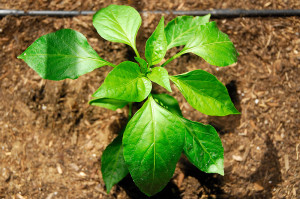
Padron peppers, are from Galicia in Spain. Picked when small and green, they're sauteed in oil, sprinkled with coarse salt, and served as a traditional tapas appetizer
Then of course, there are the tomatoes, but I’ll update on those in a separate post as we’re doing our tomato grafting experiment this year.
Cucumbers, and beans, though will be transplanted out this weekend, before they crawl out of the greenhouse on their own.
We need to pull out the early season garlic too.
The orchard trees are finally growing significantly larger. All the fruit trees are still quite young, but this year it actually looks like we’ll get a more substantial fruit harvest from some of the trees, including the aprium, the Indian Free peach, and some of the apples.
The citrus trees are in full bloom, and delighting the bees as usual, who seem especially drawn to the nectar of the Meyer lemon tree.
The strawberries are in full swing at the moment too, although I admit I need to revamp the strawberry bed a bit this year, as it’s been somewhat neglected. That was on my spring to-do list…but likely now will get pushed to fall.
The herb garden, like last year, is looking its best this time of year. The perennial herbs, like thyme, sage, and oregano have filled in a lot this year, and the sage is almost finished blooming.
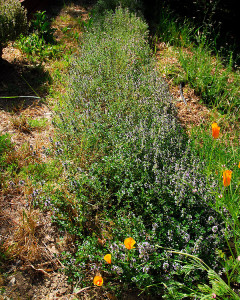
A year later, and it's completely covered the edger board...it also looks like I have a little more weeding to do!
The lavender is about to burst with blooms, and this summer I’m determined to make a batch or two of lavender cookies.
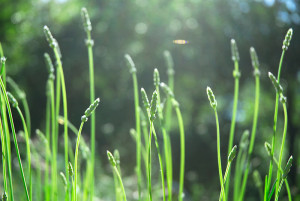
'Provence' lavender has a number of uses in the kitchen, and the flowers are as good in cookies, as they are used in an herb rub for roasted lamb
The annual herbs, including basil and sweet mace are hoping I get them transplanted out soon. Just starting to bloom though is this fennel that was allowed to overwinter in the garden.
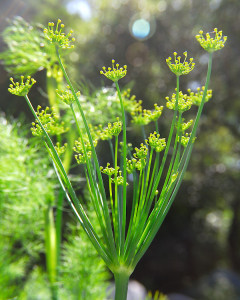
We always keep some fennel growing in the garden, and allow it bloom as various beneficial insects are attracted to it
Last year we noted lots of immature lady bugs among the fennel fronds, but this week we found someone completely different.
An Anise Swallowtail (Papilio zelicaon) caterpillar! Maybe you’re used to seeing them in your garden, but this the very first one I’ve ever found here, so it was a very exciting find! It seemed to be enjoying devouring the fronds, I delighted in watching it do just that. They’re actually quite dexterous creatures.
I almost felt a little like Alice in Wonderland staring up at this enormous creature, that seemed impossibly large to be supported by something as flimsy as a fennel frond.
If we continue to maintain fennel in the kitchen garden, as this is a preferred food source for this species, I’m hoping we’ll see more swallowtail butterflies in the garden too.
Despite being a couple of weeks behind this season, we are catching up, and hoping that the warmer weather will continue, and bring us a better summer harvest this year, especially the tomatoes. We’ll update next time on how our tomato grafting project is going so far this season, but first, I have more transplanting to do!

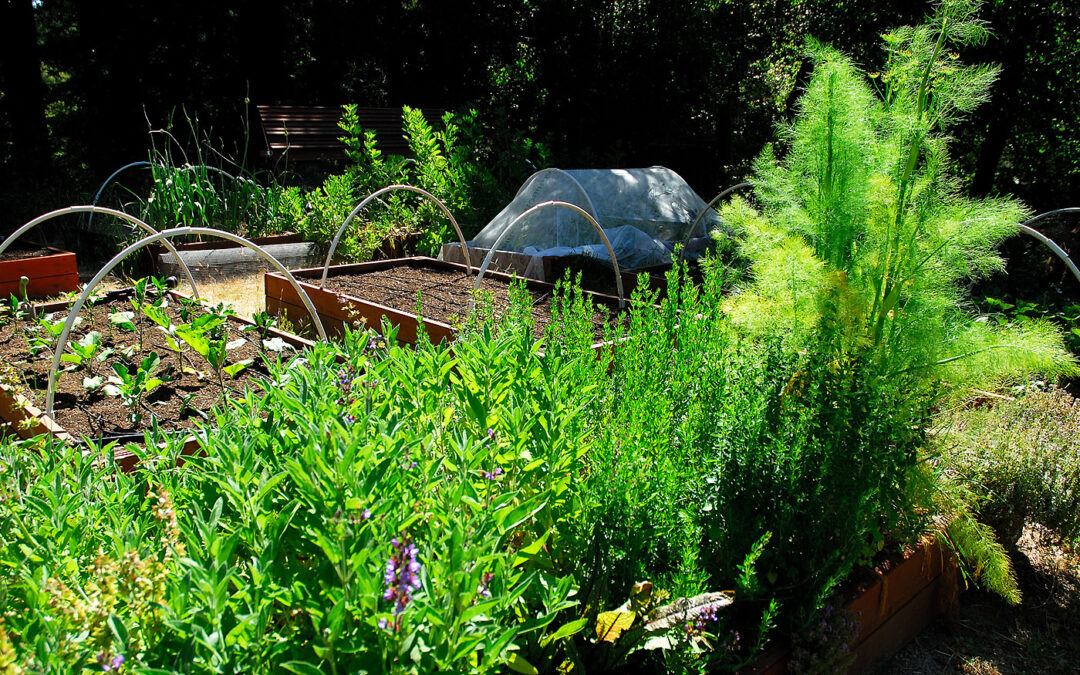
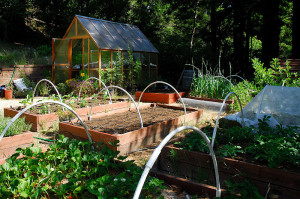

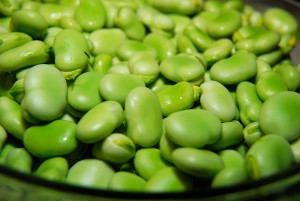
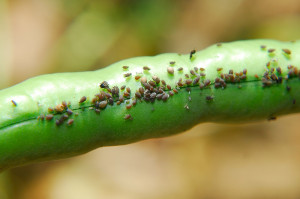

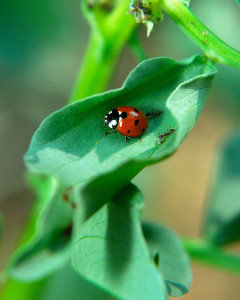

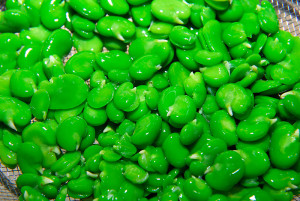
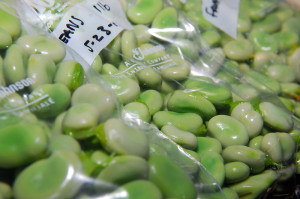
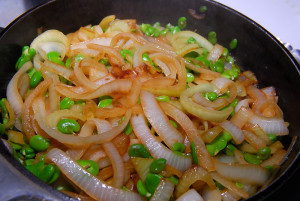

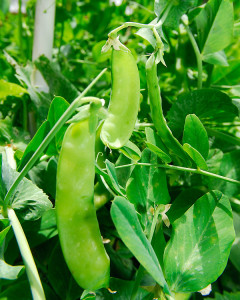
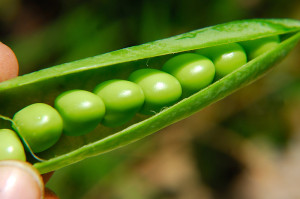

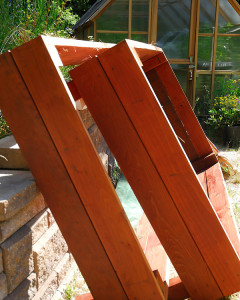
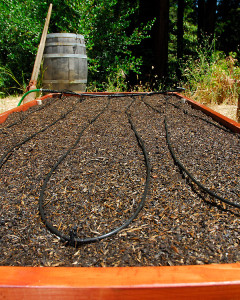
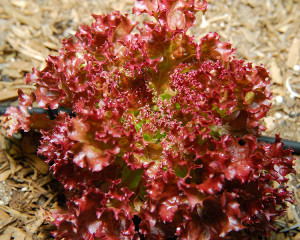

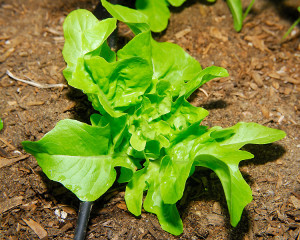
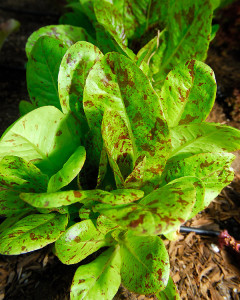
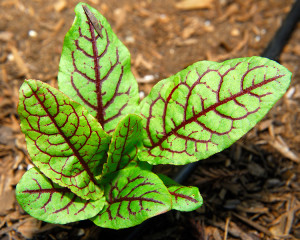

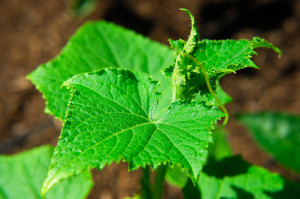
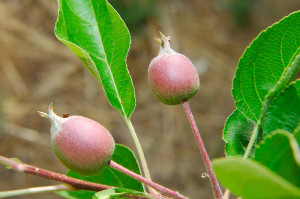
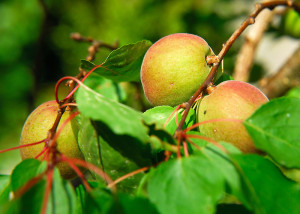
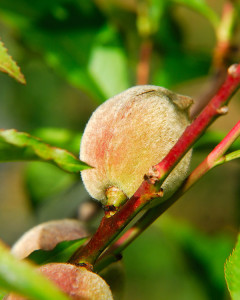

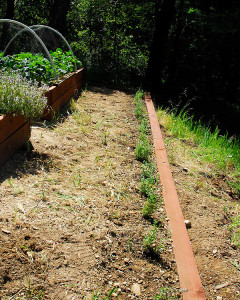

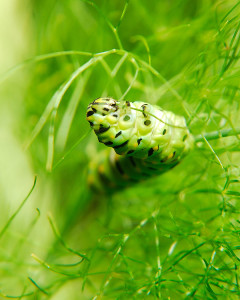

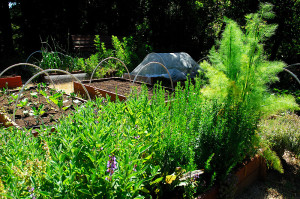







Whew! When do you sit and have a beer with all that going on? Now, I’m starting to see why I’m so far behind…lack of effort.
I admit, this year there hasn’t been much lounging around. Soon though, I hope. Maybe I should add ‘hammock installation’ to our project list 😉
You have been very busy. Just this week, I had to pull out the lettuce because it was bolting in the heat. Your lettuce looks delicious. And I plant lots of parsley for the larvae of the Black Swallowtail butterfly. The larvae look very similar to the Anise Swallowtail. Your thyme is huge and so lush. I have one that is almost that size but not quite.
Oh, I forgot about the parsley. I had a giant parsley plant that overwintered, but started to bolt. I wish I’d looked under the leaves now before I pulled it.
I have never eaten a fava bean. I could not even tell you how to cook or grow one, and you are drowning in them. But I can only imagine shelling all of them as not too fun. That photo of the caterpillar eating the fennel is gorgeous. Strange to say on insect like that, but it really is a stunning photo.
Some caterpillars really are very beautiful, and in this case, the butterfly is stunning too. Shelling favas isn’t my favorite thing to do, but they are worth it. I think next I’m going to make a fava bean spread for crostini 😉
Looks like you’re playing catchup quite well in the garden! I’m trying the Padron peppers this year too, which should be a fun eating experience. And speaking of eating, I’m curious about those lavender cookies. Mrs HA is looking to make some lavender shortbread with ours,which is just now ready to start harvesting.
Goodness, your lavender is ready to harvest, and mine isn’t blooming yet. I swear, I need to move to Indiana, you seem to consistently be a month or two ahead of us. So much for ‘sunny California’ 😛
I am still amazed at all you accomplish. You have a real farm going on. I seem to remember something about having to prepare lava beans correctly or they’re toxic. Is that right? Your comment about lavender reminds me that I have some lavender sugar from last year. I might make some sugar cookies with it. Shortbread sounds even better.
Oh, Lavender sugar, I should make some of that this year. I usually keep some Vanilla sugar around too. All this talk of cookies and shortbread is making me hungry!
I just looked up lava beans, and they are toxic to people who lack the enzyme glucose 6 phosphate dehydrogenase. I learned something else. Most raw dry beans are toxic, but the toxicity goes away with cooking. However, slow cookers don’t heat hot enough to destroy the toxin and some people have gotten sick from eating beans that weren’t cooked at a boiling temperature. Soaking dry beans helps soak out this toxin (can’t remember what it is called, a glycoside?), which is why the soaking water should be discarded.
I have a friend whose brother almost died as a baby when his mother ate fava beans while she was nursing. Her family was of Egyptian origin, and people of middle eastern descent can have a genetic condition called ‘Favism’, which is the G-6-PD deficiency you mention. It results in red blood cell lysis, and jaundice. Even exposure to fava pollen in affected individuals can be problematic.
There is a lectin, Phytohaemagglutinin, most commonly found in red kidney beans (it’s present in favas, but at lower concentrations). The agglutinin causes red blood cell ‘clumping’ in mammals. I remember as a child helping in the school home economics class being taught about the importance of soaking kidney beans, and changing the water a few times during soaking, to leach out the toxin.
What a delicious post. Thanks for sharing your kitchen garden with us.
I’m hoping the garden will become more delicious as the season progresses too!
As I was reading your post I had visions of paradise! You have worked so hard, and your rewards are great, especially if you love beans! You will certainly be enjoying the fruits of your labor months from now when the weather is cold and the garden is resting. And you will probably be thinking of how you can do it all over agin, only bigger and better. Happy gardening!
It would feel more like paradise if I had some time to just sit back and enjoy it 😉 Hopefully, with summer approaching, things will start to slow down for a while.
Oh, I always want to spot caterpillar in my garden. So far no luck :(.
We’ve been here for more than 5 years, and is the first one I’ve ever seen. This will probably inspire me to plant to more fennel and parsley this fall 🙂
You have a lot of projects going on! Despite your late start, it looks like your vegetable garden is doing all right. I had a bit of a late start during prime seed-starting season, but my kitchen garden seems to be doing all right despite my benign neglect. And what a difference a year makes–your herb garden looks amazing.
I’d forgotten how tiny those thyme plants were when we first planted them last year. That’s one of the advantages of a garden blog, you can look back to old photographs to better appreciate the changes!
Your garden is looking fabulous! Shelling peas is one of my favourite things (is that weird?!) but I’ve never attempted to shell a whole season’s worth of peas or beans. I’ve never thought of freezing favas before, as I usually just pick them as I go, but I’ve planted so many this year that I might need to think about storing some. Why do you freeze and not dry them?
It’s not weird at all, I actually don’t mind shelling peas, I just have to discipline myself so I don’t eat too many of them while I’m shelling them 😉 They are MUCH easier to get out of their pods than favas too!
I freeze the favas to help conserve some of their texture. I find once beans are dried, even after a thorough soaking, their texture is never really the same. I also don’t have to remember to soak them in advance. I can just thaw them, skin them, and use them!
I smiled at Turling’s comment because i was thinking of that too. I even wonder how you found time to reply to all comments in your posts. Also i thought there was no insects plaguing your plants, i am glad you post the aphids, so i realized your farm is also normal, haha! We have lots of aphids and mealy bugs, what do you suggest should i do to diminish their population if not totally eradicate them. thanks.
Oh, we have insects, but overall they’re not really a bother. All of our greens (Asian greens, lettuces, kale etc.) are all grown under a very lightweight row-cover. That keeps out caterpillars, leaf miners, and most aphids and their ilk. Most seedlings are transplanted out under covers too, and for those plants that require pollination, like tomatillos, cucumbers, squash and peppers, the covers are removed before they bloom. By then, a little insect damage is usually negligible, as the plants are big enough to tolerate it. I don’t strive to eradicate any of the insects here, not even the occasionally bothersome aphids. If they’re really bad, a short sharp burst of water is enough to dislodge them, but honestly, I don’t even do that most of the time. If I look more closely near large clusters of aphids, I can usually find predators like syrphid fly larvae, solider beetles, lady beetles etc. Spraying with water, I’m just as likely to knock those off too, and I rather leave them alone to dine on aphids undisturbed. I prefer to plant other plants that may help to attract more beneficial insects, like fennel, dill, hyssop etc., rather than target the pests directly. I also allow at least some plants to bolt and bloom, like Tatsoi, Broccoli, or kale, as many beneficials are attracted to their blooms. Sometimes these plants will also function as a ‘trap crop’, helping to draw some of the pests away from the crops you’d like to keep to harvest!
Clare we have such different growing seasons. may should have been heating up but still a bit cool with June ready to rush into the heart of the hot weather. Well my cool season veggies were met with May heat and slowed or bolted. Now with the June veggies in, the weather has cooled and they look sad. I am hoping the weather shifts soon. My lettuces and peas are happy though. My lavender has also just started to flower. I love this time of year…
The start of our year was a bit topsy turvy, with warm, and very dry weather through December and January. Some of our winter crop of cabbage, and broccoli, bolted very early in the season. One broccoli variety didn’t head up at all, it just bloomed! Since late March though we seem to have settled into a more normal weather pattern (although it’s RAINING as I type this). Our concern now is how much coastal fog we’ll get through June and July. Last year we had days where our tomatoes never saw the sun, and I swear, I could have grown peas, or spinach, all summer last year! 😉
Hello Clare,
It looks like things are going very well for you and that Strawberry has made my tummy rumble!
Here it’s a completely different story and so far I have 0 peas, but I am hopeful that I will eventually get Tomatoes as my poorly little plants look to be bouncing back well.
Our hot spring in march which abruptly turned into a shockingly bad April and early May will no doubt have hit many veggie gardens and growers across the UK.
I’ve been reading about how warm and dry your spring was. It’s always a bit odd when the weather in England is nicer than California, but I can imagine how much havoc it wreaked on spring gardens there. I’ll cross my fingers that your warm season crops, like tomatoes, will have an exceptionally good year to make up for it 🙂
Your garden looks terrific! Do you notice if the fennel has a negative effect on plants around it? I’ve heard that it can decrease neighboring plant growth and wonder if you’ve observed that or is it just an old wives tale…
It’s an interesting question, and I think there is sufficient evidence to show that fennel has allelopathic effects on some species of plants. I found one local study that showed fennel extract inhibits the growth of our native California poppies. I haven’t noted any inhibitory effects, but I only grow fennel in the herb garden, not in the vegetable garden. I have often heard that fennel will affect the growth of tomatoes, and other vegetable crops. That said though, we had a lot of fennel volunteers in the pea bed, and those didn’t seem affected at all. I’m sure the effects are variable between plant species, but it is something to consider when mapping out a vegetable garden plan for the season.
I love it when the garden has so much to offer!! I am looking forward to spring!!! But I still have to get through winter. It’s starting now here in Cape Town RSA! I have completed my winter garden planting and look forward to a delicious crop of green leafie veggies and this is the first time I have planted fennel!
I always have to remind myself that you’re going into winter as we head into summer. I’m a little envious you’re planting winter greens, I’m already missing kale! Keep a close eye on your fennel, I’ll be curious to see if you find lots of lady beetles or caterpillars lurking in the spring.
Delicious! Looks like you got a bumper crop of beans & peas! I have been picking lots of strawberries & raspberries. The blueberries are just ripening but they too are being eaten right off the bush. So excited that you have a swallowtail caterpillar! I hope you find more. We had a record 20 caterpillars on our fennel this spring! Now we are waiting for the butterflies.
Wow, 20 caterpillars! That sounds like a bumper crop! 😉 Can’t wait to see all the butterflies in your garden!
Wow, that looks like a lot of work! And it must take a big freezer to take in the bounty – but you’ll be so happy to have these around as winter starts!